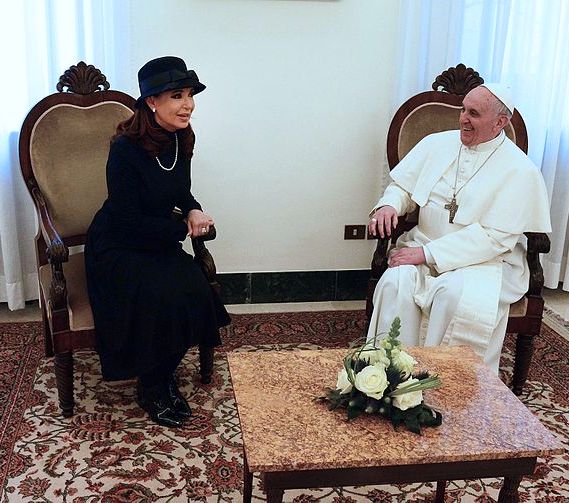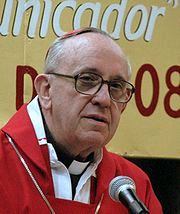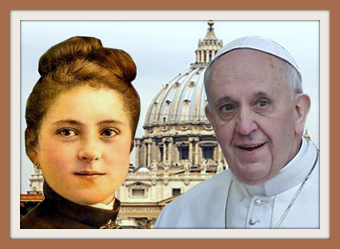Saint Therese of the Child Jesus
of the Holy Face
"A White Rose from Saint Therese" by Stefania Falasca. Pope Francis's devotion to St. Therese. March 24, 2013
A White Rose from Saint Therese
Mary and Joseph, but also the Carmelite of Lisieux: the Pope is very tied to the master/teacher of child-like spirituality: “Whenever I have a problem—he explained—I put confide it to her. I don’t ask that she solve it for me, only that she take it into her hands and help me.”
The devotion and spiritual bond of Bergoglio for the “Little Flower of Jesus.” “This is what I call her when I ask for her help.”
By Stefania Falasca
Whoever has had the opportunity to get to know and be friends with Cardinal Jorge Maria Bergoglio knows that it was his custom to include, even in a short note, an ancient image of Mary venerated in Bavaria, at Augsburg, in the Church of St. Peter, called “She who unties knots.” To this he always added a little holy card of Saint Joseph and another of the Carmelite saint and Doctor of the Church, Therese of Lisieux—almost to emphasize, by his deeply meaningful personal choice, the spiritual bond that unites him to them.
 Christina Kirchner, president of Argentina, with Pope Francis and St. Therese's white roses
Christina Kirchner, president of Argentina, with Pope Francis and St. Therese's white roses
In recent days we have seen Pope Francis refer, by his gestures and teaching, to Mary and Saint Joseph, in profound and discreet ways. Neither has the gift to Argentine President Christine Kirchner of the Aparecida Statement (the concluding text of the fifth conference of all the Bishops of Latin America), along with a white rose, gone without notice. A sensitive gesture—the gift of a rose—that the President herself did not fail to call “intimate,” like “a greeting from Saint Therese, to whom Pope Francis directs his prayers.”
But why and from where does this preference of Pope Francis for Therese come? I asked myself this even at Aparecida in 2007. I had briefly met Cardinal Bergoglio in the portico of the Brazilian Marian shrine between one meeting or another of the preparatory commission for the final statement.
He had told me that wherever the bishops gathered to work together, they were so aware of the prayers and singing of the faithful and that this gave them a lively sense of belonging and closeness to the people, to a Church that walks with its people . . . I have to admit that what came across to me in that moment in his “spiritual” tone was patronizing and vague, rather than a strong and challenging statement to be noticed.
But the Cardinal had continued: “We shouldn’t be afraid to rely solely on the tenderness of God, as Therese of Lisieux did, who is precisely for this a favored daughter of Our Lady and a great missionary saint.”
It was an understanding of the Church and her mission along the lines of the “little way” opened by the teacher of spiritual child-like spirituality, which we see today woven all through the first acts of the pontificate of Pope Francis.
I later learned that when he came to Rome to deal with this or that ministerial obligation, the cardinal always went to pray at a statue of Therese of the Child Jesus in a little Franciscan church in the Borgo near the Tiber. And also how much his devotion to the Patron of the Missions was known by his priests in Buenos Aires, especially in the poor areas of the Argentine capital.  Cardinal Bergoglio
Cardinal Bergoglio
But let’s now get back to the roses. Cardinal Bergoglio had returned to Rome at the end of 2007 for the Consistory. And with him he brought back St. Theresa: “When I have a problem—he told us—I confide it to her. I don’t ask that she solve it for me, only that she take it in her hands and help me; as a sign, I almost always receive a rose.” He then related how one time, when he had to make an important decision about a complex matter, he left it in her hands. Sometime later, an unknown woman placed three white roses at the doorstep of the sacristy.
“It was a Jesuit—he explained—Fr. Putigan, who in 1925 began to spread this personal prayer of intercession,” and he repeated a section of the “Prayer to ask for a rose”: “Little Flower of Jesus, ask God today that he will grant the petition that I now place with confidence into your hands.”
One perceives in his way of speaking a shyness combined with simplicity, a sincere confidence, so much so that I was moved to imitate him. In a particular situation, taking him as an example, I prayed like him to St. Therese, but to my great regret I received no rose. At my first opportunity I briefly told him about it over the telephone. I told him, “Father, remember that prayer about roses . . . look, nothing…no roses for me. But listen, I’m not surprised; I can understand it; these things work with holy people like you, who have their lives in order, and I am certainly not what one might call a virtuous flower.”
First silence on the other end, then his calm voice replied, blowing me away another time: “This means that she will answer you with a greater grace than the one you asked for.” It really turned out that way.

translated from "Una rosa bianca da Santa Teresa" by Stefania Falasca in the March 24, 2013 issue of l'Avvenire. English translation copyright Maureen O'Riordan 2013.
A gift for the feast of St. Therese of Lisieux, October 1, 2013
 First Steps on the Little Way of St. Therese
First Steps on the Little Way of St. Therese
Treat yourself to Fr. Peter-John Cameron's excellent online booklet "First Steps on the Little Way of St. Therese of Lisieux," presented by the Knights of Columbus. Enjoy!
Eight hundred pilgrims venerate the writing-desk of St. Therese of Lisieux in Seattle
The writing-desk of Saint Therese of Lisieux at St. James Cathedral in Seattle, Washington
Saturday, September 14, 2013

"Eight hundred pilgrims venerate the writing-desk
of St. Therese of Lisieux in Seattle"
by Maureen O'Riordan for
"Saint Therese of Lisieux:
A Gateway"
The first visit of the writing-desk of St. Therese to a cathedral in the United States took place on Saturday morning, September 14, 2013, at St. James Cathedral in Seattle, sponsored by the Pontifical Mission Societies in the United States, which is coordinating a national mission tour of this writing-desk, and the Seattle Missions Office. Corrinna Laughlin, Pastoral Assistant for Liturgy at St. James Cathedral, coordinated the event for the Cathedral. She estimated that about eight hundred people came to pray in the presence of the writing-desk that morning. See a photo album of the 800 pilgrims venerating the writing-desk of St. Therese of Lisieux in Seattle, Washington.
Dr. Keith Egan to Speak on Saint Therese at the Carmelite Monastery in Barrington, R.I., September 29, 2013
 Dr. Keith Egan
Dr. Keith Egan
Dr. Keith Egan, theologian and author, will speak on “Therese of Lisieux, Gifted Daughter of Saint Teresa of Avila" on Sunday, September 29, 2013 at 2:00 p.m. Keith will explore what wisdom Saint Therese learned from Teresa and the wisdom that Teresa has for us. For details, please visit Carmelstream. You may also read "Carmelite nuns plan 3-year celebration of 500th birth anniversary of founder" in the Providence Journal. The lecture is free and open to the public.
St. Therese sent a white rose to Pope Francis on September 8, 2013. Why that date?

On September 26, 2013, the Vatican Insider reported that on Sunday, September 8, 2013, the day after the prayer vigil for peace in the world, Pope Francis received a rose from St. Therese of Lisieux. The Pope authorized the Archbishop of Ancona and Osimo, Edoardo Menichelli, to disclose this news at a press conference in Pedaso, in the region of Marche, Italy, at which Archbishop Menichelli presented a book by theologian and writer Gianni Gennari entitled Teresa di Lisieux. Il fascino della santità. I segreti di una dottrina ritrovata (Thérèse of Lisieux. The fascination of sainthood. Secrets of a rediscovered doctrine) and published by Lindau. We now know that this was the book Pope Francis took with him when he flew to Brazil last July.
As the Pope was walking through the Vatican gardens, a worker presented him with a white rose. Archbishop Menichelli said:
“The Pope told me he received the freshly-picked white rose out of the blue from a gardener as he was taking a stroll in the Vatican Gardens on Sunday 8 September. The Pope sees this flower as a “sign”, a “message” from Saint Thérèse of Lisieux, whom he had turned to in a moment of worry the day before.”
At the prayer vigil for peace the evening before, the joyful mysteries of the rosary were recited, and, after each decade, a stanza of Therese's poem "Why I Love You, O Mary" (related to the joyful mystery that had just been prayed) was read. In Vatican Insider Andrea Tornielli notes that the Pope did not tell the Archbishop that the white rose had any connection to the prayer vigil for peace in Syria, but, of course, the international situation must have been a great anxiety on the day of the prayer vigil.
The white rose was linked to Pope Francis while he was still Cardinal Bergoglio. In the book, Pope Francis: Conversations with Jorge Bergoglio: His Life in His Own Words by Sergio Rubin and Francesca Ambrogetti (originally published in 2010 under the title "El Jesuita" ("The Jesuit") and now available in English), then-Cardinal Bergoglio revealed that St. Therese of Lisieux was his favorite saint and that he turns to her in time of need. He kept a photo of her on his library shelf with a vase of white roses in front of it. "When I have a problem I ask the saint, not to solve it, but to take it in her hands and help me accept it; almost always, I receive a rose as sign." See more about Pope Francis, St. Therese, and the rose.
Although the famous line "After my death I will let fall a shower of roses" has been widely publicized in connection with St. Therese, so that most people see the rose as a sign of the favors she has obtained for humanity from God, in Therese's lifetime she identified herself with the rose and longed to be "unpetalled" to give glory to God. See more about this symbolism, read Therese's poem "The unpetalled rose," and listen to a recording of her cousin, Jeanne Guerin, singing the poem in French.
Why did St. Therese send this rose to Pope Francis on September 8?
Of course, St. Therese wanted to console the Pope as he and the world were praying for peace. On September 8, 1890, she wrote in her "Profession letter," which she carried over her heart as she made her vows:
"May the things of earth never be able to trouble my soul, and may nothing disturb my peace. Jesus, I ask You for nothing but peace, and also love, infinite love without any limits other than Yourself, love which is no longer I but You, my Jesus."
(The Prayers of Saint Therese of Lisieux, tr. Aletheia Kane, O.C.D. Washington, D.C.: Washington Province of Discalced Carmelites, 1996, p. 38).
But the choice of the date September 8, which was a day of unique graces for Therese, may have a deeper personal significance for St. Therese's relationship with Pope Francis himself. First, September 8 is the feast of the Birth of Mary and the date of Therese's profession of vows in 1890. (See a story with photos here).
Fr. Adolphe Roulland, MEP. Photo: Paris Foreign Missions Society
Second, in 1896 Therese learned for the first time of a great grace she received on that date. On November 1, 1896 she wrote to her spiritual brother, the newly ordained priest Father Adolphe Roulland of the Foreign Missions Society in Paris, then serving as a missionary in China:
Allow me to confide a secret to you that was just revealed to me by the sheet of paper on which are written the memorable dates of your life.
On September 8, 1890, your missionary vocation was saved by Mary, Queen of Apostles and Martyrs; on that same day, a little Carmelite became the spouse of the King of heaven. Bidding an everlasting adieu to the world, she had one goal, to save souls, especially the souls of apostles. From Jesus, her divine Spouse, she asked particularly for an apostolic soul; unable to be a priest, she wanted that in her place a priest may receive the graces of the Lord, that he have the same aspirations, the same desires as herself . . . .
Brother, you know the unworthy Carmelite who offered this prayer. Do you not think, as I do, that our union confirmed on the day of your priestly ordination began on September 8? . . . I believed I would meet only in heaven the apostle, the brother whom I had asked from Jesus; but this Beloved Saviour, raising a little the mysterious veil that hides the secrets of eternity, has seen fit to give me in this exile the consolation of knowing the brother of my soul, of working with him for the salvation of poor infidels.
Oh! how great is my gratitude when I consider the kind attention of Jesus!. . . What is He reserving for us in heaven if here below His love dispenses surprises so delightful?
More than ever, I understand that the smallest events of our life are conducted by God; He is the One who makes us desire and who grants our desires . . . .
Letters of St. Therese of Lisieux, Volume II, 1890-1897, tr. John Clarke, O.C.D. (Washington, D.C.: Washington Province of Discalced Carmelites, 1988), pp. 1014-1015.
Therese writes of Mary's having "saved" the missionary vocation of Adolphe Roulland. She is referring to a pilgrimage he made to the shrine of Notre Dame de la Delivrande (in English, "Our Lady of Ransom" or "Our Lady of Perpetual Help") in Douvres la Delivrande, Normandy (about an hour's drive from Lisieux) on September 8, 1890. At the Apostolic Process Father Roulland testified:
"On September 8, 1890, I was having some hesitancy concerning my vocation and entrance into the Major Seminary. While I was praying in the chapel of Our Lady of Ransom, I suddenly and definitively came to a decision. I learned later that on the same September 8, 1890, the day of the Servant of God’s Profession, she had asked Our Lord to give her the soul of a priest, and she pointed out the link between these two events.”
Apostolic Process, p. 2903, cited in Letters of St. Therese of Lisieux, Volume II, p. 1019, footnote 3.
Therese was always attuned to dates as a sign of grace. She had sent Father Roulland the "days of grace" in her life and had asked him to send her the memorable dates of his life, that she might be particularly united to him in prayer and thanksgiving on those anniversaries. With his letter of September 25-26, 1896, he sent the list, including "Vocation saved by Our Lady of Perpetual Help: September 8, 1890." It's in response to this list of dates that Therese, on November 1, 1896, wrote the letter quoted above.
Father Roulland died in 1934, nine years after his "little sister" was canonized. Now that his mission on earth is complete, might St. Therese have asked God to choose Pope Francis as the priest who now "in her place may receive the graces of the Lord, that he have the same aspirations, the same desires as herself . . . .?" Does she now call Pope Francis "the brother of my soul?"